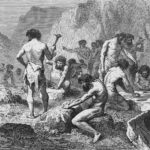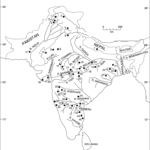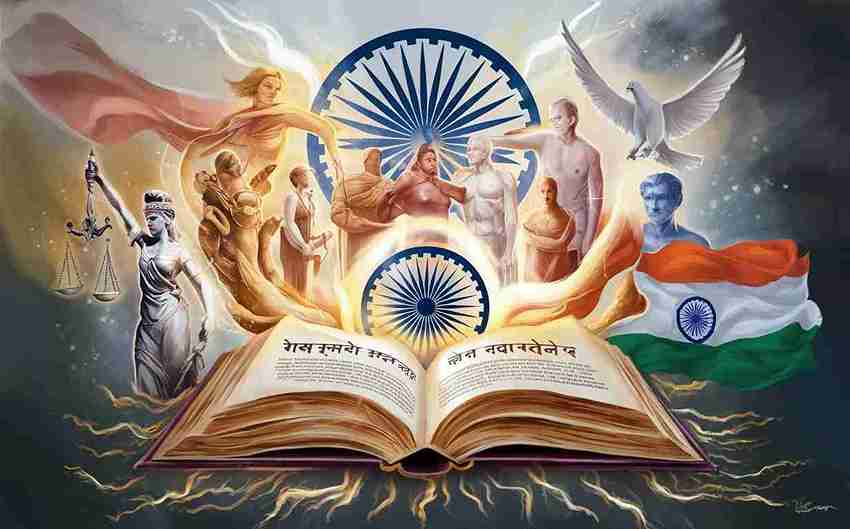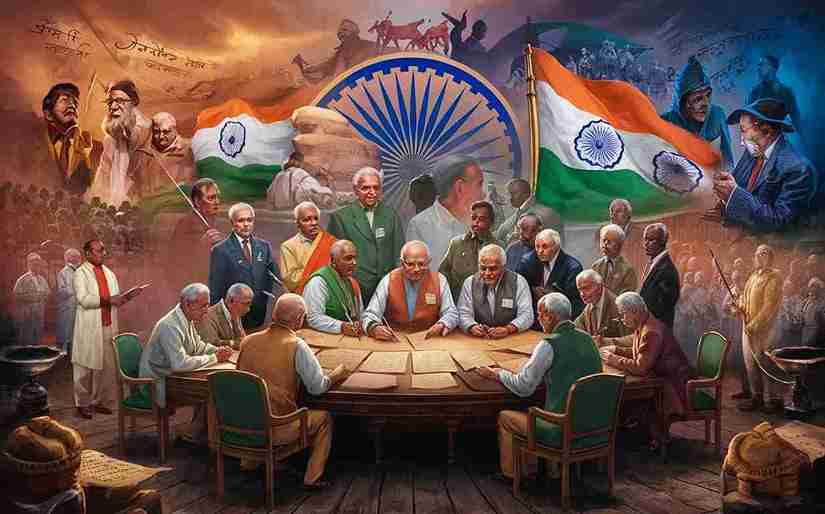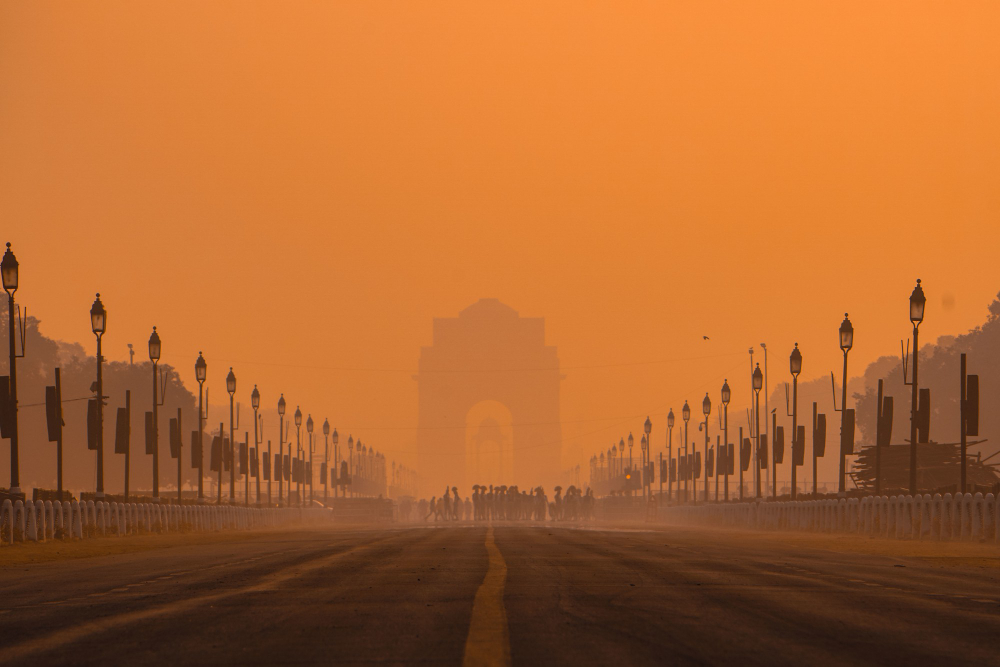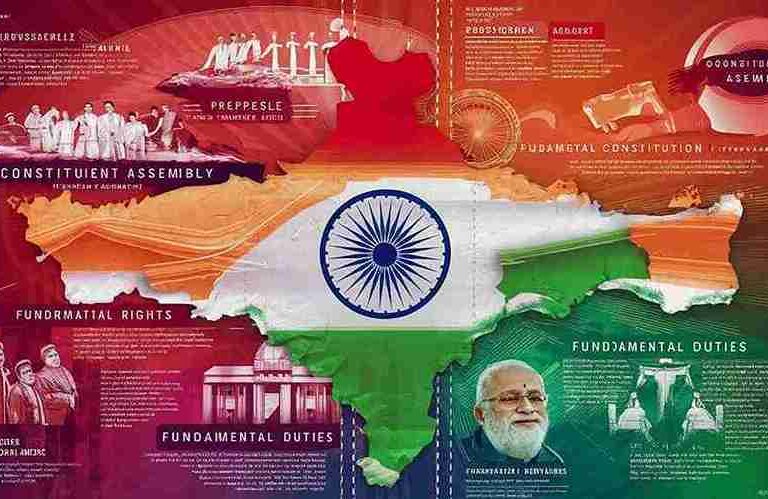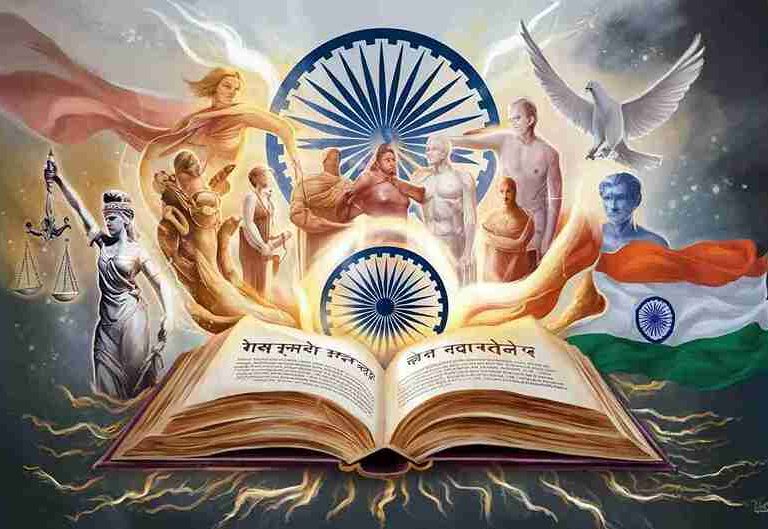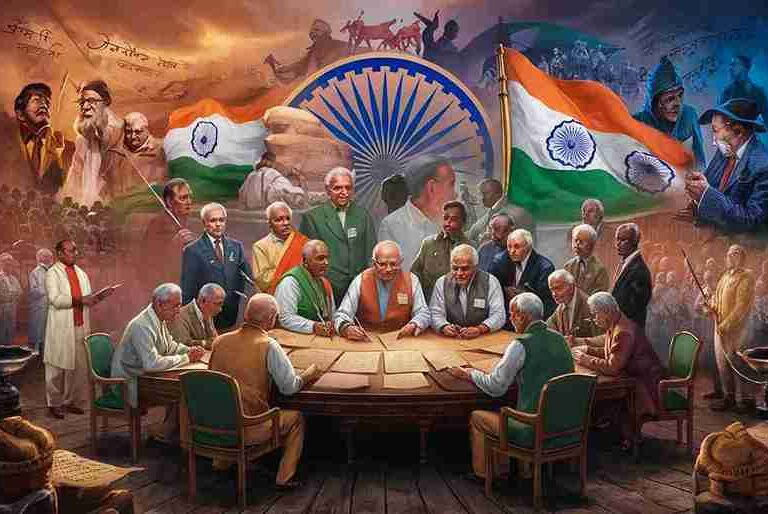OUTSTANDING FEATURES OF OUR INDIAN CONSTITUTION PART 1
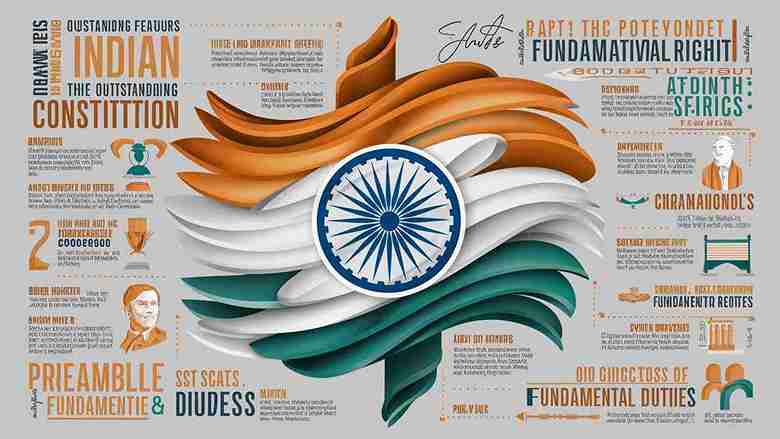
INDIAN CONSTITUTION
OUTSTANDING FEATURES OF OUR INDIAN CONSTITUTION PART 1
I. THE Indian Constitution is remarkable for many outstanding featu res which will distinguish it from other Constitutions even though it has been prepared after “ransacking all the known Constitutions of the world” and most of its provisions are substantially borrowed from others. As Dr. Ambedkar observed,
“One likes to ask whether there can be anything new in a Constitution framed at this hour in the history of the world. More than hundred years have rolled when the first written Constitution was drafted, It has been followed by many other countries reducing their Constitutions to writing Given these facta, all Constitutions in their main provisions must look similar. The only new things, if there be any, in a Constitution framed so late in the day are the variations made to remove the faults and to accommodate it to the needs of the country.”
So, though our Constitution may be said to be a ‘borrowed’ Constitution, the credit of its framers lies in gathering the best features of each of the existing Constitutions and in modifying them with a view to avoiding the faults that have been disclosed in their working and to adapting them to the existing conditions and needs of this country. So, if it is a ‘patchwork’, it is a ‘beautiful patchwork.

There were members in the Constituent Assembly who criticised the Constitution which was going to be adopted as a ‘slavish imitation of the West’ or ‘not suited to the genius’ of the people. Many apprehended that it would be unworkable. But the fact that it has survived for about sixty years, while Constitutions have sprung up only to wither away in countries around us, such as Burma and Pakistan, belies the apprehension of the critics of the Indian Constitution.
II. It must, however, be pointed out at the outset that many of the original features of the 1949-Constitution have been substantially modified by the 78 Amendments which have been made up to 1996, of which the 42nd Amendment Act, 1976 (as modified by the 43rd and 44th Amendment Acts, 1977-78), has practically recast the Constitution in vital respects.
The 73rd Amendment Act which was brought into force in April 1993 has added 16 articles which provide for establishment of and elections to Panchayats. They comprise a new part, Part IX. By the same Amendment a new schedule (Sch. 11) has been added which enumerates the functions to be delegated to the Panchayats.
The 74th Amendment Act was passed to establish Municipalities and provides for elections to them. It has inserted Part 9A consisting of 18 articles. Schedule 12 inserted by the Amendment mentions the functions to be assigned to the Municipalities. This Amendment came into force on 1st June 1993.
III. The Constitution of India has the distinction of being the most lengthy and detailed constitutional document the world has so far produced. The original Constitution contained as many as 395 Articles and 8 Schedules (to which additions were made by subsequent amendments). Even after the repeal of several provisions it still (in 2008) contains 444 Articles and 12 Schedules.
During the period 1950-2000, while a number of Articles have been omitted,-64 Articles and 4 Schedules have been added to the Constitution, viz., Arts. 21A, 31A-31C, 35A, 39A, 43A, 48A, 51A, 131A, 134A, 139A, 144A, 224A, 233A, 239A, 239AA, 239AB, 239B, 243, 243A to 243ZG, 244A, 257A, 258A, 290A, 300A, 312A, 323A, 3238, 338A, 350A, 350B, 361A, 363A, 371A-371-1, 372A, 378A, 3944.
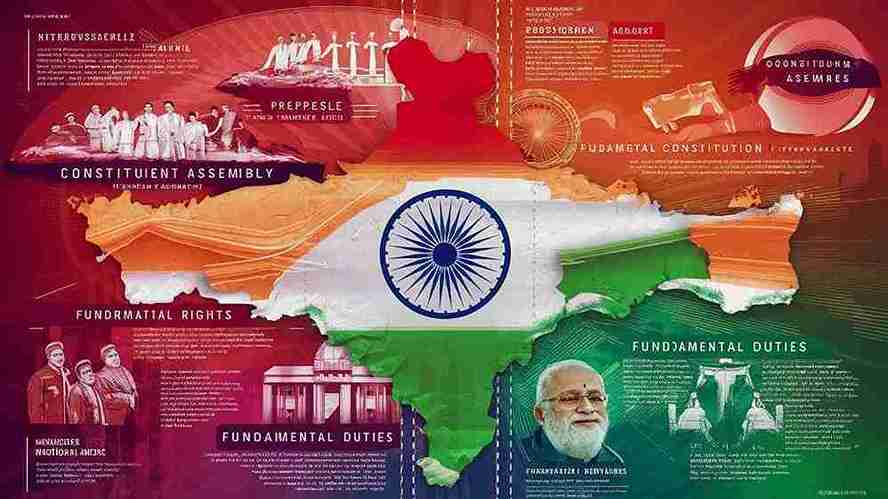
This extraordinary bulk of the Constitution is due to several reasons
(1) The framers sought to incorporate the accumulated experience gathered from the working of all the known Constitutions and to avoid all defects and loopholes that might be anticipated in the light of those Constitutions. Thus, while they framed the Chapter on the Fundamental Rights upon the model of the American Constitution, and adopted the Parliamentary system of Government from the United Kingdom,
they took the idea of the Directive Principles of State Policy from the Constitution of Eire, and added elaborate provisions relating to Emergencies in the light of the Constitution of the German Reich and the Government of India Act, 1935, On the other hand, our Constitution is more full of words than other Constitutions because it has embodied the modified results of judicial decisions made elsewhere interpreting comparable provisions, in order to minimise uncertainty and litigation.
(ii) Not contented with merely laying down the fundamental principles of governance (as the American Constitution does), the authors of the Indian Constitution followed and reproduced the Government of India Act, 1935, in providing matters of administrative detail, not only because the people were accustomed to the detailed provisions of that Act,
but also because the authors had the apprehension that in the present conditions of the country, the Constitution might be perverted unless the form of administration was also included in it. In the words of Dr. Ambedkar, Any such surreptitious subversion of the Constitution was sought to be prevented by putting detailed provisions in the Constitution itself, so that they might not be encroached upon without amending the Constitution.
The very adoption of the bulk of the provisions from the Government of India Act, 1935, contributed to the volume of the new Constitution inasmuch as the Act of 1935 itself was a lengthy and detailed organic law. So much was borrowed from that Act because the people were familiar with the existing system.
It was also felt that the smooth working of an infant democracy might be jeopardised unless the Constitution mentioned in detail things which were left in other Constitutions to ordinary legislation. This explains why we have in our Constitution detailed provisions about the organisation of the Judiciary, the Services, the Public Service Commissions, Elections and the like. It is the same ideal of ‘exhaustiveness” which explains why the provisions of the Indian Constitution as to the division of powers between the Union and the States are more numerous than perhaps the aggregate of the provisions relating to that subject in the Constitution of the U.S.A., Australia and Canada.
(iii) The vastness of the country (see Table I), and the peculiar problems to be solved have also contributed towards the bulk of the Constitution. Thus, there is one entire Part Part XVI] relating to the Scheduled Castes and Tribes and other backward classes; one Part [Part XVIII relating to Official Language and another [Part XVII] relating to Emergency Provisions.
iv) While the Constitution of the United States deals only with the Federal Government and leaves the States to draw up their own Constitutions, the Indian Constitution provides the Constitutions of both the Union and the Units (Le, the States), with the same fullness and precision. Since the Units of the federation differed in their historical origins and their political development, special provisions for different classes of the Units had to be made, such as the Part B States (representing the former Indian States), the Part C States (representing the Centrally Administered areas) and some smaller Territories in Part D. This also contributed to the bulk of the 1949- Constitution (see Table III).

Though, as has just been said, the Constitution of the State was provided by the Constitution of India, the State of Jammu and Kashmir was accorded a special status and was allowed to make its own State Constitution. Even all the other provisions of the Constitution of India did not directly apply to Jammu and Kashmir but depended upon an Order made for the President in Constitution with the Government of State, for which provision had to be made in Art. 370 [see Chap. 15].
Even after the inauguration of the Constitution special provisions have been inserted (eg.. Arts. 371- 3711], to meet the regional problems and demands in certain States, such as Nagaland, Assam, Manipur, Andhra Pradesh, Maharashtra, Gujarat, Sikkim, Mizorma, etc.
(v) Not only are the provisions relating to the Units elaborately given, the relations between the Federation and the Units and the Units inter se, whether legislative or adminis trative, are also exhaustively codified, so as to eliminate conflicts as far as possible. The lessons drawn from the political history of India which induced the framers of the Constitution to give it a unitary bias, also prompted them to make detailed provisions “regarding the distribution of powers and functions between the Union and the States in all aspects of their administrative and other activities, and also as regards inter-State relations, co-ordination and adjudication of disputes amongst the States.
(vi) There is not only a Bill of Rights containing justiciable fundamental rights of the individual [Part III on the model of the Amendments to the American Constitution but also a Part [Part IV) containing Directive Principles, which confer no justiciable rights upon the individual but are nevertheless to be regarded as ‘fundamental in the governance of the country’, being in the nature of each House present and voting, which, again, must be majority of the total membership of the House [see Chap. 101.
On the other hand, Parliament has been given the power to alter or modify many of the provisions of the Constitution by a simple majority as is required for general legislation, by laying down in the Constitution that such changes “shall not be deemed to be amendments of the Constitution”. Instances to the point are(a) Changes in the names, boundaries, areas of, and amalgamation and separation of States [Art. 4]. (b) Abolition or creation of the Second Chamber of a State Legislature (Art. 169]. (c) Administration of Scheduled Areas and Scheduled Tribes [Para 7 of the 5th Schedule and Para 21 of the 6th Schedule]; (d) Creation of Legislatures and Council of Ministers for certain Union Territories (Art. 239A(2)).
Yet another evidence of this flexibility is the power given by the Constitution itself to Parliament to supplement the provisions of the Constitution by legislation. Though the makers of the Constitution aimed at exhaustive ness, they realised that it was not possible to anticipate all exigencies and to lay down detailed provisions in the Constitution to meet all situations and for all times.

(a) In various Articles, therefore, the Constitution lays down certain basic principles and empowers Parliament to supplement these principles by legislation. Thus,
(i) as to citizenship, Arts. 5-8 only lay down the conditions for acquisition of citizenship at the commencement of the Constitution and Art. 11 vests plenary powers in Parliament to legislate on this subject. In pursuance of this power, Parliament has enacted the Citizenship Act, 1955, so that in order to have a full view of the law of citizenship in India, study of the Indian Constitution has to be supplemented by that of the Citizenship Act.
(ii) Similarly, while laying down certain fundamental safeguards against preventive detention, Art. 22(7) empowers Parliament to legislate on some subsidiary matters relating to the subject. The laws made under this power, have, therefore, to be read along with the provisions of Art. 22.
(iii) Again, while banning ‘untouchability’, Art. 17 provides that it shall be an offence ‘punishable in accordance with law, and in exercise of this power, Parliament has enacted the Protection of Civil Rights Act, 19557 which must be referred to as supplementing the Indian constitutional prohibition against untouchability.
(iv) While the Indian Constitution lays down the basic provisions relating to the election of the President and Vice-President, Art. 71(3) empowers Parliament to supplement these constitutional provisions by legislation, and by virtue of this power Parliament has enacted the Presidential and Vice-Presidential Elections Act, 1952.
The obvious advantage of this scheme is that the law made by Parliament may be modified according to the exigencies for the time being, without having to resort to a constitutional amendment.
(b) There are, again, a number of articles in the Indian Constitution which are of a tentative or transitional nature and they are to remain in force only so long as Parliament does not legislate on the subject, eg., exemption of Union property from State taxation [Art. 285]; suability of the State [Art. 300(1).
The Indian Constitution, thus, ensures adaptability by prescribing a variety of modes in which its original text may be changed or supplemented, a fact which has evoked approbation from Prof. Wheare-
“This variety in the amending process is wise but is rarely found.
This wisdom has been manifested in the ease with which Sikkim, a Protectorate since British days, could be brought under the Consti tution first, as an ‘associate State’ (35th Amendment Act), and then as a full-fledged State of the Union (36th Amendment Act, 1975).
V. This combination of the theory of fundamental law which underlies the written Indian Constitution of the United States with the theory of Parliamentary sovereignty’ which underlies the unwritten Constitution of England is the result of the liberal philosophy of the framers of the Indian Constitution which has been so nicely expressed by Pandit Nehru:

“While we want this Constitution to be as solid and permanent as we can make it, there is no permanence in Indian Constitutions. There should be a certain flexibility. If you make anything rigid and permanent, you stop the nation’s growth, the growth of a living, vital, organic people. In any event, we could not make this Constitution as rigid that it cannot be adapted to changing conditions. When the world is in turmoil and we are passing through a very swift period of transition, what we may do to-day may not be wholly capable tomorrow.”
The flexibility of our Constitution is illustrated by the fact that during the first 59 years of its working, it has been amended 94 times. Vital changes have thus been effected by the First, Fourth, Twenty-fourth, Twenty-fifth, Thirty-ninth, Forty-second, Forty-fourth, Seventy-third and Seventy-fourth Amendments to the Indian Constitution, including amendments to the fundamental rights, powers of the Supreme Court and the High Courts.
Dr. Jennings characterised our Constitution as rigid for two reasons:
(a) that the process of amendment was complicated and difficult,
(b) that matters which should have been left to ordinary legislation having been incorporated into the Indian Constitution, no change in these matters is possible without undergoing the process of amendment. We have seen that the working of the Constitution during six decades has not justified the apprehension that the process of amendment is very difficult [see also Chap. 10, post). But the other part of his reasoning is obviously sound. In fact, his comments on this point have proved to be prophetic. He cited Art. 224 as an illustration of a provision which had been unnecessarily embodied in the Constitution:
“An example taken at random is article 224, which empowers a retired judge to sit in a High Court. Is that a provision of such Indian constitutional importance that it needs to be constitutionally protected, and be incapable of amendment except with the approval of two-thirds of the members of each House sitting and voting in the Union Parliament?”
As Table IV will show it has required an amendment of the Indian Constitution, namely, the Seventh Amendment of 1956, to amend this article to provide for the appointment of Additional Judges instead of recalling retired Judges. Similar amendments have been required, once to provide that a Judge of a High Court who is transferred to another High Court shall not be entitled to compensation [Art. 222] and, again, to provide for compensation. It is needless to multiply such instances since they are numerous.

The greatest evidence of flexibility, however, has been offered by the amendments since 1976. The 42nd Amendment Act, 1976, after the Consti tution had worked for over quarter of a century, introduced vital changes and upset the balance between the different organs of the State. Of course, behind this flexibility lies the assumption that the Party in power wields more than a two-thirds majority in both Houses of Parliament.
VI. It is also remarkable that though the framers of the Indian Constitution attempted to make an exhaustive code of organic law, room has been left for the growth of conventions to supplement the Indian Constitution in matters where it is silent. Thus, while the Constitution embodied the doctrine of Cabinet responsibility in Art. 75, it was not possible to codify the numerous conventions which answer the problems as they may arise in England, from time to time, in the working of the Cabinet system.
Take, for instance, the question whether the Ministry should resign whenever there is an adverse vote against it in the House of the People, or whether it is at liberty to regard an accidental defeat on a particular measure as a ‘snap vote 12 Again, the Indian Constitution cannot possibly give any indication as to which issue should be regarded as a ‘vital issue’ by a Ministry, so that on a defeat on such an issue the Ministry should be morally bound to resign. Similarly, in what circumstances a Ministry would be justified in advising the President to dissolve Parliament instead of resigning upon an adverse vote, can only be established by convention.
Sir Ivor Jennings is, therefore, justified in observing that-
“The machinery of government is essentially British and the whole collection of British constitutional conventions has apparently been incorporated as conventions.”
VII. While the Directive Principles are not enforceable in the Courts, the Fundamental Rights, included in Part III, are so enforceable at the instance of any person whose fundamental right has been infringed by any action of the State, executive or legislative and the remedies for enforcing these rights, namely, the writs of habeas corpus, mandamus, prohibition, quo warranto and certiorari, are also guaranteed by the Indian Constitution. Any law or executive order which offends against a fundamental right is liable to be declared void by the Supreme Court or the
High Court.
It is through a misapprehension of these provisions that the Indian Constitution has been described by some critics as a ‘lawyer’s paradise”, 12 According to Sir Ivor Jennings, this is due to the fact that the Constituent Assembly was dominated by the lawyer-politicians’. It is they who thought of codifying the individual rights and the prerogative writs though none in England would ever cherish such an idea. In the words of Sir Ivor-

“Though no English lawyer would have thought of putting the prerogative writs into a Constitution, the Constituent Assembly did so. These various rious factors have given India a most complicated Indian Constitution. Those of us who claim to be constitutional lawyers can look with equanimity on this exaltation of our profession. But Indian constitutions are intended to enable the process of Government to work smoothly, and not to provide fees for constitutional lawyers. The more numerous the briefs the more difficult the process of government becomes. India has perhaps placed too much faith in us.”10
With due respect to the great Indian constitutional expert, 10 these observations disclose a failure to appreciate the very foundation of the Indian Constitution. Sir Ivor omits to point out that the fathers of the Indian Constitution preferred the American doctrine of ‘limited government to the English doctrine of Parliamentary sovereignty.
In England, the birth of modern democracy was due to a protest against the absolutism of an autocratic executive and the English people discovered in Parliamentary sovereignty an adequate solution of the problem that faced them.
The English political system is founded on the unlimited faith of the people in the good sense of their elected representatives. Though, of late, detractions from its omnipotent authority have taken place because the ancient institution at Westminster has grown incapable of managing myriads of modern problems with the same ease as in Victorian age, nonetheless, never has anybody in England thought of placing limitations on the authority of Parliament so that it might properly behave.
The Founding Fathers of the American Constitution, on the other hand, had the painful experience that even a representative body might be tyrannical, particularly when they were concerned with a colonial Empire. Thus it is that the Declaration of Independence recounts the attempts of the British “Legislature to extend an unwarrantable jurisdiction over us” and how the British people had been “deaf of the voice of justice”.
At heavy cost had the colonists learnt about the frailty and weakness of human nature when the same Parliament which had forced Charles I to sign the Petition of Right (1628) to acknowledge that no tax could be levied without the consent of Parliament, did, in 1765, and the years that followed, insist on taxing the colonies, regardless of their right of representation, and attempt to enforce such undemocratic laws through military rule.

Hence, while the English people, in their fight for freedom against autocracy, stopped with the establishment of the supremacy of the law and Parliament as the sole source of that law, Americans had to go further and to assert that there is to be a law superior to the Legislature itself and that it was the restraints of this paramount written law that could only save them from the fears of absolutism and autocracy which are ingrained in human nature itself.
As will be more fully explained in the Chapter on Fundamental Rights, the Indian experience of the application of the British Rule of Law in India was not altogether happy and there was a strong feeling that it was not administered with even hands by the foreign rulers in India as in their own land. The “Sons of Liberty’ in India had known to what use the flowers of the English democratic system, viz., the Sovereignty of Parliament and the Rule of Law, could be put in trampling down the rights of man under an Imperial rule. So, in 1928, long before the dawn of independence in India, the Motilal Nehru Committee asserted that
“Our first care could be to have our fundamental rights guaranteed in a manner which will aut permit their withdrawal under any circumstances.”
Now, judicial review is a necessary concomitant of ‘fundamental rights’, for, it is meaningless to enshrine individual rights in a written Constitution as ‘fundamental rights’ if they are not enforceable, in Courts of law, against any organ of the State, legislative or executive. Once this choice is made, one cannot help to be sorry for the litigation that ensues. Whatever apprehensions might have been entertained in some quarters in India at the time of the making of the Indian Constitution, there is hardly anybody in India to-day who is aggrieved because the Supreme Court, each year, invalidates a dozen of statutes and a like number of administrative acts on the ground of violation of the fundamental rights.
At the sarne time, it must be pointed out that since the inauguration of the indian Constitution, various provisions have been inserted into the Indian Constitution by amendments, which have taken out considerable areas from the pale of judicial review, eg, by inserting Arts. 31A-31C; and by 1995 as many as 284 Acts, Central and State, have been shielded from judicial review on the ground of contravention of the Fundamental Rights, by enumerating them under the 9th Schedule, which relates to Art. 31B.1
VIII. An independent Judiciary, having the power of ‘Judicial review’, is another prominent feature of our Constitution.
On the other hand, we have avoided the other-extreme, namely, that of ‘Judicial supremacy’, which may be a logical outcome of an over-emphasis on judicial review, as the American experience demonstrates.
Judicial power of the State exercisable by the Courts under the Constitution as sentinels of Rule of Law is a basic feature of the Indian Constitution.
OUTSTANDING FEATURES OF OUR INDIAN CONSTITUTION PART 2
About the Author
Sisir Mondal
Administrator
My name is SISIR MONDAL, I complete my graduate from University of Kalyani , West Bengal, India . I am like to build WordPress website and also developing this type of website . If you want your website , you can contact me trough email. thanks to visit this site.

